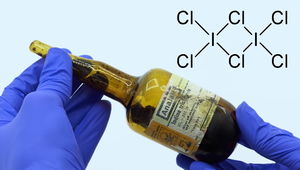Iodine trichloride
 Ampoule containing ICl3 and its dimer formula
| |
| Names | |
|---|---|
| IUPAC name
Iodine trichloride
| |
| Other names
Diiodine hexachloride (dimer)
iodine(III) chloride | |
| Properties | |
| ICl3 (monomer) I2Cl6 (dimer) | |
| Molar mass | 233.264 g/mol (monomer) 466.5281 g/mol (dimer) |
| Appearance | Yellow or red solid |
| Odor | Pungent |
| Density | 3.203 g/cm3 (-40 °C) 3.11 g/cm3 (15 °C) |
| Melting point | 63 °C (145 °F; 336 K) |
| Boiling point | Decomposes |
| Reacts | |
| Solubility | Reacts with alcohols Soluble in acetic acid, acetone, arsenic trichloride, bromine, dichloroacetic acid, methyl ethyl ketone, phosgene, phosphoryl chloride, sulfuryl chloride Slightly soluble in liq. SO2[1][2] |
| Thermochemistry | |
| Std enthalpy of
formation (ΔfH |
899.5 kJ/mol |
| Hazards | |
| Safety data sheet | Sigma-Aldrich |
| Flash point | Non-flammable |
| Related compounds | |
| Related compounds
|
Iodine monochloride |
| Except where otherwise noted, data are given for materials in their standard state (at 25 °C [77 °F], 100 kPa). | |
| Infobox references | |
Iodine trichloride is an interhalogen compound of iodine and chlorine. In the solid state is present as a planar dimer I2Cl6, better represented as Cl2I(μ-Cl)2ICl2, with two bridging Cl atoms.
Contents
[hide]Properties
Chemical
Iodine trichloride slowly fumes in open air, more vigorously in liquid form. It reacts with water, slowly with cold water and rapidly with warm/hot water. It also reacts vigorously with alkalis.
- 2 ICl3 + 3 H2O → 5 HCl + HIO3 + ICl (cold water)
- 5 ICl3 + 9 H2O → 15 HCl + 3 HIO3 + I2 (hot water)
Iodine trichloride decomposes above its boiling point to iodine monochloride and chlorine gas.
- ICl3 → ICl + Cl2
Addition of tin(II) chloride to ICl3 gives tin(IV)chloro-iodide (SnCl2I2). This in turn evolves into tin(IV) chloride, releasing purple iodine vapors.
Red phosphorus and lithium borohydride ignite on contact with ICl3.[3]
Physical
Iodine trichloride is a bright yellow solid which upon exposure to light turns red due to the presence of elemental iodine.
Availability
Iodine trichloride is sold by chemical suppliers, but it's not easy to acquire.
Preparation
Can be prepared by reacting iodine with an excess of liquid chlorine at −70 °C.
Projects
- Compound collecting
- Pyrotechnic demonstrations
Handling
Safety
Iodine trichloride is highly corrosive and toxic. Wear proper protection when handling it.
Storage
The only safe way to store this compound is in glass ampoules.
Disposal
Iodine trichloride can be safely neutralized by adding it in very cold water containing very diluted solution of sodium hydroxide and sodium thiosulfate.
Gallery
References
- Jump up ↑ Finkelstein, W.; Zh. Russ. Fiz. - Khim. O - va., Chast Khim.; vol. 58; (1926); p. 565
- Jump up ↑ Beckmann, E.; Junker, F.; Z. Anorg. Chem.; vol. 55; (1907); p. 375 - 375
- Jump up ↑ https://www.youtube.com/watch?v=2-CbgjdFZ8g
Relevant Sciencemadness threads
- Articles containing unverified chemical infoboxes
- Chemical compounds
- Inorganic compounds
- Iodine compounds
- Chlorine compounds
- Interhalogens
- Oxidizing agents
- Materials that react with water
- Materials unstable in basic solution
- Things that should NOT be messed with except by professionals
- Things that can kill you very quickly

